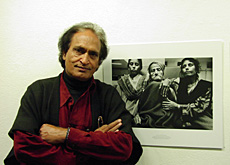Images recall horror of Bhopal

Photographs of what has been described as the world's biggest chemical disaster have gone on display in Switzerland.
Taken by Indian photographer, Raghu Rai, the pictures show the immediate aftermath of the 1984 tragedy at Bhopal, near Bombay.
Greenpeace Switzerland is hosting the touring exhibition, at the Volkart Foundation near Winterthur, as part of the organisation’s campaign for an international agreement on corporate accountability for environmental abuses.
Some 20,000 people died from gas exposure in Bhopal, and Greenpeace estimates that about 150,000 survivors remain chronically ill.
It says groundwater has been contaminated since the explosion at Union Carbide’s pesticide plant released toxic gases into the air.
Explosion aftermath
At the opening of the exhibition, Rai – who works for the photographers’ cooperative, Magnum Photos – gave a graphic description of the scenes he witnessed just hours after the explosion.
“There was death all over,” he told swissinfo.
“Nobody was talking to anybody because they were all coping with the dead bodies. Some who were still breathing their last were being taken to hospitals. It was so shocking that there was nothing to ask.
“It took me quite a while to focus on anything, because everywhere the shock was so intense that one was just going crazy…it was a matter of controlling my emotions and rising above it all, to do the job.”
The result of Rai’s work in Bhopal is a disturbing collection of black and white images, which can be seen at Volkart’s Coalmine gallery until November 15.
Greenpeace officials used the launch of the exhibition to accuse Dow Chemical, which took over Union Carbide in 2001, of showing no sign of taking responsibility for the Bhopal legacy.
Survivors visit Switzerland
One of the Swiss campaigners, Matthias Wüthrich, told swissinfo that Greenpeace had invited some Bhopal survivors to Switzerland’s national exhibition, Expo.02, to publicise their plight.
“This is not a past tragedy but a continuing one,” he said, adding that Switzerland had a key role to play in the campaign because the European headquarters of Dow Chemical is at Horgen, near Zurich.
Last year, Greenpeace gave Dow employees bottles of contaminated water to mark the 17th anniversary of the explosion.
In a statement to swissinfo, Dow said Union Carbide had reached a $470 million settlement with the Indian government of all claims associated with the disaster.
It said the 1989 settlement had been upheld by the Indian Supreme Court, which found it to be “just, equitable and reasonable”.
The company also made it clear that its acquisition of Union Carbide’s stock did not include any of the company’s liabilities.
“Dow Chemical, therefore, while agreeing that nobody should ever forget the terrible human tragedy of the Bhopal gas disaster, does not accept any responsibility for the disaster or any of its after effects.”
swissinfo, Richard Dawson
Born in 1942 in what is now Pakistan, Delhi-based Raghu Rai is a member of Magnum, Paris.
His photographs and photo essays have appeared in major national and international magazines, and his one-man shows have been held in India, Hamburg, Prague, New York, Paris and Tokyo.
He was recognised as the United States Photographer of the Year in 1993.

In compliance with the JTI standards
More: SWI swissinfo.ch certified by the Journalism Trust Initiative
You can find an overview of ongoing debates with our journalists here . Please join us!
If you want to start a conversation about a topic raised in this article or want to report factual errors, email us at english@swissinfo.ch.